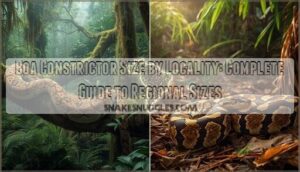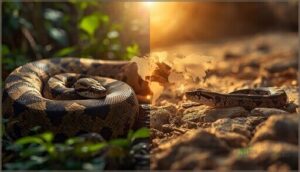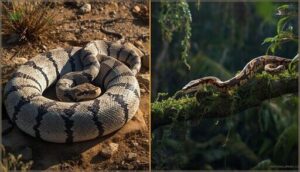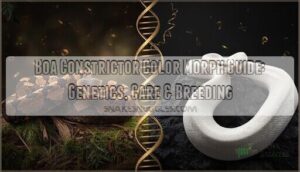This site is supported by our readers. We may earn a commission, at no cost to you, if you purchase through links.
A Colombian boa constrictor can stretch to nine feet in a well-maintained vivarium, while her Brazilian cousin might top out at six. This isn’t random variation—it’s the fingerprint of geography, written in scales and vertebrae.
Boa constrictor size based on locality reflects millions of years of adaptation to distinct ecosystems, from the humid lowlands of Suriname to the arid scrublands of Argentina. Genetics sets the blueprint, but rainfall patterns, prey availability, and even altitude fine-tune the outcome.
Understanding these regional differences helps you predict adult size before you bring a hatchling home, ensures proper enclosure planning, and deepens your appreciation for how profoundly environment shapes these fascinating constrictors.
Table Of Contents
Key Takeaways
- Boa constrictor size varies dramatically by geographic origin, with Colombian boas reaching 6–9 feet while island populations like Hog Island rarely exceed 4–6 feet due to evolutionary adaptation to local ecosystems.
- Genetics sets the baseline size potential, but environmental factors like rainfall patterns, prey availability, temperature, and habitat quality directly influence whether a boa reaches its maximum growth potential.
- Female boas consistently outgrow males by 18–40% across all localities due to reproductive demands, making gender the most predictable size differentiator regardless of origin.
- Captive feeding schedules impact growth rate more than any other controllable factor, with weekly-fed juveniles reaching 950 grams compared to 750 grams for monthly-fed specimens by year two.
Factors Influencing Boa Constrictor Size
Understanding what drives boa constrictor size helps you predict how large your snake will grow and what to expect throughout its life. Several interconnected factors determine whether a boa reaches six feet or pushes closer to ten, from the genetics it inherits to the environment you provide.
Let’s break down the key influences that shape how big these snakes actually get.
Genetics and Subspecies Variation
When you’re choosing a boa constrictor, understanding genetic traits and subspecies differentiation becomes essential. Boa constrictor subspecies evolved through distinct clade lineages, with sequence divergence reaching 5–7% between some groups—enough to distinguish separate species.
Genetic markers reveal phenotypic variation in size, from island dwarfism in isolated populations to larger mainland forms. Snake genetics show how gene flow shapes these differences across localities.
Island populations show convergent island phenotypes with reduced body size.
Environmental and Habitat Influences
Beyond genetic blueprints, environmental conditions profoundly shape boa constrictor size across geographic distribution. Habitat fragmentation has reduced forest cover by 246% in some Amazon regions, constraining growth potential. Climate effects, humidity influence, and microhabitat preferences all interact to determine how large your snake grows. Boa constrictors are known as non-venomous snakes with heavy bodies.
- Water proximity increases average body size by 12% due to concentrated prey and hydration.
- Dense rainforests produce boas averaging 2.5–3.5 meters, while fragmented habitats rarely exceed 2 meters.
- Temperature increases of 1.5–2.0°C accelerate growth rate by 10–20% in warmer climates.
Diet and Growth Rate
What you feed your boa—and how often—shapes its growth rate more than any other controllable factor. Feeding frequency drives development: juveniles fed weekly at 10% body mass reach 950 grams by year two, compared to 750 grams for monthly feeders. Prey size matters less than consistency, though proper caloric intake prevents obesity while supporting lean muscle growth.
| Feeding Schedule | Average Body Mass at 2 Years |
|---|---|
| Weekly (10% body mass) | 950 grams |
| Monthly (larger meals) | 750 grams |
| Biweekly (moderate prey) | 850 grams |
Gender Differences in Size
Gender plays a decisive role in adult size. Female boa constrictors consistently outgrow males, averaging 18.4% longer in snout-vent length and often weighing 1.8–2.3 times more—a clear female size advantage tied to reproductive capacity.
Males counter with proportionally longer tail length and more substantial spur development, anatomical traits evolved for courtship.
This sexual dimorphism holds true across localities, wild and captive populations alike.
Overview of Boa Constrictor Localities
Boa constrictors span a vast geographic range across the Americas, and their size can vary dramatically depending on where they originate. Understanding these regional differences—what herpetologists call “localities”—gives you a clearer picture of what to expect from your boa’s adult size.
Let’s break down the key localities, how they’re identified, and why this information matters for anyone keeping or studying these noteworthy snakes.
Geographic Range and Distribution
You’ll find boa constrictors spread across an impressive geographic distribution of snakes, from northern Mexico all the way to northern Argentina. This Boa constrictor habitat showcases striking Habitat Diversity and adaptability across the Americas:
- They thrive from sea level to approximately 2,000 meters in Elevational Range
- Biogeographic Regions include both Nearctic (northern Mexico) and Neotropical zones
- Natural populations exist across 15+ countries in Central and South America
- Introduced Populations have established themselves in southern Florida and Caribbean islands
- Range Fragmentation from habitat loss has created distinct regional populations
Major Recognized Localities
Herpetologists recognize distinct boa constrictor localities based on geographic variations in size, pattern, and coloration. These populations, from Colombian red-tails to Mexican dwarfs, show considerable size discrepancies shaped by isolation and adaptation. Understanding boa constrictor morphs and their origins helps you appreciate conservation status and select appropriate captives.
| Locality Category | Examples |
|---|---|
| South American Mainland | Colombian, Suriname, Peruvian, Argentine |
| Central American | Nicaraguan, Honduran, Costa Rican, Mexican Sonoran |
| Island Dwarf Forms | Hog Island, Crawl Cay, Corn Island, Roatan |
| Miniature Types | Tarahumara, Tamaulipas, Cayo Cochino |
| Notable Subspecies | B. c. occidentalis, B. c. imperator, B. c. amarali |
Locality Identification and Importance
Accurate locality documentation shapes every aspect of responsible boa keeping. You’ll rely on multiple lines of evidence—genetic lineages, morphological indicators, and verified records—to distinguish true localities from unsubstantiated claims. Here’s why locality verification matters:
- Genetic lineages preserve 5.2 million years of evolutionary divergence across boa constrictor localities
- Morphological indicators like scale counts and saddle patterns confirm regional phenotype
- Captive management depends on knowing adult size expectations for each locality
- Locality verification through CITES documents prevents mislabeling boa constrictor morphs
- Ethical significance aids unique adaptations from hybridization and furthers conservation goals
South American Boa Constrictor Sizes
South American boa constrictors represent some of the largest and most variable populations within the species. Their sizes can differ dramatically depending on which country or region they originate from, with some localities producing true giants while others remain appreciably more compact.
Let’s examine the size characteristics of the major South American localities you’re likely to encounter.
Colombian Boa Size Range
When you’re looking at pure Colombian locality Boa imperator, adult size usually ranges from 6 to 9 feet, with females consistently outpacing males by 1 to 2 feet. Gender dimorphism is pronounced—females average 40 to 50 pounds, while males rarely exceed 30.
Maximum length rarely surpasses 10 feet, and captive growth rates depend heavily on your feeding schedule and husbandry practices.
Peruvian and Surinamese Boa Sizes
Peruvian and Surinamese red-tailed boas represent the true giants of Boa constrictor localities. Their phenotype differences persist even under identical captive growth rates and feeding schedules, making locality a key factor in your size expectations.
Here’s what you need to know about these South American specimens:
- Adult Peruvian boa size: Females routinely reach 9 to 10 feet, with outstanding individuals approaching 11 to 13 feet under prime conditions.
- Surinamese boa size: Adults usually measure 7 to 9 feet, though some females occasionally attain 10 to 12 feet.
- Sexual size dimorphism: Females from both localities outsize males by 1 to 2 feet, with Peruvian females displaying noticeably greater girth and muscle mass.
- Locality size comparison: Peruvian boas consistently achieve larger dimensions than their Surinamese and Guyana counterparts, even when raised identically.
- Weight differences: Surinamese boas average 30 to 50 pounds, while large Peruvian females can exceed this range considerably.
Hatchlings from both localities start at 18 to 20 inches, reaching 3 to 4 feet within the first year under proper care.
Brazilian Boa Constrictor Size Traits
Brazilian boa constrictors occupy a unique niche in the locality spectrum, with adults averaging 5.5 to 6 feet—considerably smaller than their Peruvian cousins. Sexual dimorphism is evident, as females generally surpass males by several inches and have noticeably heavier builds.
| Trait | Males | Females |
|---|---|---|
| Adult size | 5–6 feet | 6–7 feet |
| Weight range | 8–15 lbs | 15–25 lbs |
| Growth rate | Moderate | Faster early on |
| Maturity age | 3–4 years | 4–5 years |
Habitat influence and diet practices—especially rodent availability in humid forests—directly impact your boa’s growth rate and final phenotype.
Argentine and Bolivian Localities
Argentine and Bolivian boa constrictor localities showcase dramatic size dimorphism, with Argentine boas—Boa constrictor occidentalis—reaching 5 to 10 feet, though females often push past 13 feet. Bolivian boas, B. c. amarali, are more compact at 6 to 7 feet.
The conservation status for Argentine boas is endangered due to habitat threats. Sourcing captive-bred phenotypes furthers ethical stewardship and preserves these striking South American localities.
Central American and Island Boa Sizes
Central American and island boa constrictors are generally smaller than their South American cousins, making them popular choices for keepers with space constraints. These localities have adapted to diverse environments ranging from tropical rainforests to arid coastal islands, and their adult sizes reflect these geographic pressures.
You’ll find significant variation across this region, with some populations producing true dwarf boas while others reach moderate lengths.
Nicaraguan and Honduran Dwarf Boas
Among Central America’s most sought-after localities, dwarf boas from Nicaragua and Honduras rarely exceed 5 feet, even when you’re feeding them regularly in captivity.
Females of Nicaraguan Boa imperator generally reach 5 feet, while males stay closer to 4 feet—showcasing clear sexual dimorphism.
This compact size makes these localities exceptionally popular among keepers who prefer manageable snakes without sacrificing the classic boa temperament.
Costa Rican and Panamanian Boa Sizes
Costa Rican and Panamanian boa constrictors display notable regional variation in size and phenotype across Central America. Your Costa Rican locality females generally reach 6 to 8 feet, while Panamanian boas often mature smaller at 4 to 5 feet in captivity.
Gender dimorphism remains pronounced—females consistently outweigh males and achieve greater length, with captive growth patterns reflecting both genetics and controlled feeding schedules.
Mexican and Sonoran Localities
Moving north from Central America, you’ll find Mexican and Sonoran boas represent true dwarf localities, with adults generally reaching just 4 to 6 feet in captivity. Boa sigma from Mexico’s west coast shows coastal variation in size, while genetic control strongly influences these compact dimensions.
Key size metrics you should know:
- Sonoran Desert boas average 2 to 4 feet as adults
- Mexican localities rarely exceed 5.5 feet in the wild
- Females grow 15% to 20% larger than males
- Captive growth requires 4 to 6 years to maturity
- Habitat pressure correlates with declining adult size trends
These boa imperator populations demonstrate how locality directly shapes maximum length potential.
Island Localities (e.g., Hog Island, Cayos)
On the Cayos Cochinos islands of Honduras, you’ll encounter textbook insular dwarfism: Hog Island boas rarely exceed 1.2 to 1.8 meters (4 to 6 feet) as adults, roughly 30% to 50% smaller than mainland Boa constrictor.
Environmental conditions—limited resources and geographic isolation—drive this size reduction. Sexual dimorphism persists, with females averaging 120 cm versus males at 96 cm, yet population structure remains stable across these tiny island ecosystems.
Comparing Boa Size in Captivity Vs. Wild
You might assume a boa constrictor grows to the same size whether it’s in the wild or living in your home, but that’s rarely the case. Captive conditions—from feeding schedules to enclosure space—can dramatically influence how large your boa gets, and these differences vary depending on locality.
Let’s break down what really happens when you compare wild and captive growth across different boa populations.
Impact of Captive Diet and Care
Your boa’s maximum snake size isn’t just about genetics—feeding habits and captive environment shape growth dramatically. Snakes fed 10% of their body weight weekly reached 1,818 grams, versus 1,425 grams in biweekly-fed boas over the same period, demonstrating how feeding frequency directly influences mass and robustness.
| Aspect | Impact on Size & Health |
|---|---|
| Snake Nutrition | Balanced rodent/bird snake diet optimizes growth; deficiencies stunt development |
| Obesity Prevention | Proper prey sizing (under 15% body weight) prevents fatty liver disease |
| Environmental Enrichment | 75–95°F temps + adequate space support healthy digestion |
| Lifespan Extension | Controlled feeding protocols enable 20–30 year lifespans |
Dietary deficiencies manifest as stunted growth and metabolic disorders, while overfeeding accelerates maturity but compromises longevity—balance is everything.
Growth Differences by Locality in Captivity
When you compare growth patterns across localities, you’ll see how geography hardwires distinct adult size outcomes in your boa constrictor. Mainland boas mature faster than island varieties, even when feeding and enclosure size remain identical—sexual size dimorphism persists across all regions, with females consistently outgrowing males by 15–25%.
| Locality | Male Adult Size (Captive) | Female Adult Size (Captive) |
|---|---|---|
| Colombian | 5–6 feet | 6–8 feet |
| Peruvian | 6–7 feet | 7–10 feet |
| Hog Island | 2.5–3 feet | 3.5–4 feet |
| Sonoran | ~5 feet | 5–6 feet |
| Brazilian | 6–8 feet | 8–10 feet |
Captive growth rates diverge considerably. Peruvian red-tails increased mass by 1,307% annually under ideal conditions, while dwarf island localities plateaued earlier. Distribution impacts growth trajectories more than any feeding protocol can override.
Common Myths About Boa Size
You’ve probably heard rumors that all boas reach monstrous lengths—but peer-reviewed records tell a different story. Most adults max out at 6–8 feet, with Hog Island boas routinely staying under 4 feet. The sizing prey myth, where snakes supposedly measure owners before attacking, lacks any scientific backing whatsoever.
| Myth | Reality | Evidence |
|---|---|---|
| Giant size rarity is overstated | Average captive females reach 8 feet | Verified records contradict 18-foot claims |
| Boas measure prey before eating | No behavioral studies support this | Urban legend, not instinctual feeding |
| Unlimited growth potential | Genetics cap size by locality | Central American boas stay under 6 feet |
| Exceeding other snakes in length | Anacondas and retics surpass boas | Anacondas reach 20+ feet regularly |
Record sizes common in older publications often misidentified anacondas as boa constrictors—modern zoological standards dismiss these unverified reports.
Importance of Ethical Sourcing and Conservation
When you choose a captive-bred boa, you’re voting against the illegal wildlife trade that’s already slashed wild populations by up to 93.5% in some regions. Ethical sourcing through sustainable breeding programs directly combats habitat destruction and poaching, two conservation challenges threatening subspecies survival across the Americas.
| Conservation Priority | Threat Level | Action Required |
|---|---|---|
| Habitat preservation | Critical in Gran Chaco | Reforestation, protected corridors |
| Ethical pet trade enforcement | High demand persists | CITES compliance, captive documentation |
| Sustainable breeding expansion | Growing but insufficient | Certified operations, genetic tracking |
| Wildlife conservation funding | Underfunded in key zones | Community programs, policy advocacy |
Proof of captive origin isn’t bureaucratic red tape—it’s your guarantee that your boa didn’t contribute to the 81.2% female population crash documented in trade-affected localities.
Proof of captive origin ensures your boa isn’t part of the devastating 81.2% female population crash caused by wildlife trade
Frequently Asked Questions (FAQs)
How do climate cycles affect locality size trends?
When global temperatures rise or rainfall patterns shift, they don’t just alter weather—they reshape reptile populations.
Climate cycles drive measurable changes in boa locality size through temperature impacts, precipitation effects, and elevation influence across geographic distributions.
Can crossbreeding localities produce larger offspring?
Yes, genetic mixing can yield larger offspring through hybrid vigor, though phenotypic plasticity means results vary widely. Litter variations increase, but ethical considerations around preserving pure locality genetic traits remain critically important.
Do parasites limit boa growth in wild populations?
Yes, parasites constrain growth in wild boas. Gastrointestinal helminths, protozoa, and viral infections reduce body condition, slow growth rate, and increase mortality, creating environmental parasite variation that limits your snake’s health and eventual size potential.
What age do boas reach maximum size?
Most boas reach their maximum adult size between 3 and 5 years of age.
Growth patterns are influenced by gender differences, locality variation, and maturity timeline.
Though slow growth continues throughout their lifespan.
Are locality size differences visible in juveniles?
A Colombian neonate measuring 22 inches dwarfs an 11-inch Tarahumara hatchling at birth.
You’ll notice locality size differences immediately in juveniles—dwarf localities stay visibly smaller throughout early growth patterns, making identification straightforward.
Conclusion
Your Colombian boa won’t shrink in a small tank—but she also won’t surprise you with twelve feet of snake if her lineage says otherwise. Boa constrictor size based on locality is a contract written in DNA, signed by climate, and honored across generations.
When you match enclosure dimensions to geographic origin rather than wishful thinking, you’re not just planning space. You’re respecting evolutionary history, and your snake will show you the difference every time she stretches her full, predictable length.
- https://www.britannica.com/animal/boa-constrictor
- https://amphibian-pug-rzk5.squarespace.com/s/DwarfBoaConstrictors.pdf
- https://reptifiles.com/boa-constrictor-care/boa-species-subspecies/
- https://darrenhamillreptiles.com/boa-constrictor-husbandry/
- https://ecourses.uprm.edu/pluginfile.php/388115/mod_resource/content/6/22%20Mariana_Travieso_Diffoot%20-%20MARIANA%20TRAVIESO-DIFFOOT.pdf














